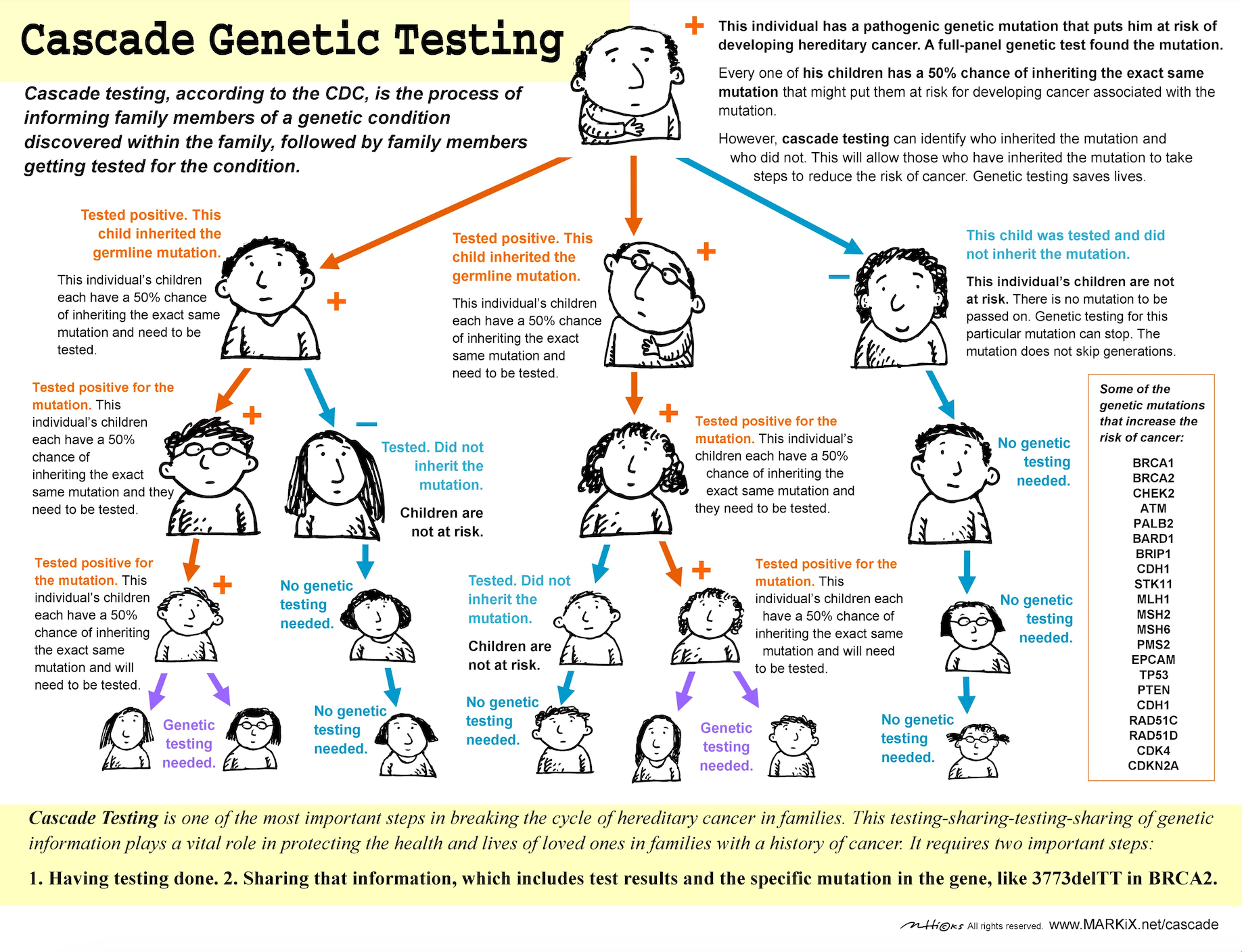Cascade genetic testing is one of the most important tools available to help break the cycle of hereditary cancer in families. With over fifty known hereditary cancer syndromes, it should be a commonly used tool. And with Mayo Clinic scientists finding in a study that “1 in 8 patients with cancer had an inherited cancer-related gene mutation,” cascade testing should be a standard of care. Yet, cascade testing is underutilized.
Frustratingly, although the term has been around for decades, it is rarely discussed in literature about cancer. Over the last couple years, I have picked up some books that focus solely on hereditary cancer, some recently published. But I was shocked to find no mention of cascade testing. To be sure I didn’t miss something while reading, I turned to the index of these books and the term was not there. How could this be? A proven method for reducing hereditary cancer cases, and it is not even acknowledged.
Cascade testing is the testing, sharing, testing, sharing of genetic information among blood relatives. For some individuals with a family history of cancer, it can be lifesaving. It requires two important steps. First, having the testing done. Then, openly sharing any positive test results with family members. And that includes sharing the specific mutation. For example, the pathogenic c.5137delG variant in a BRCA1 gene. In addition, this information needs to be shared as soon as it is known.
I’m not sure when I first heard the term, but I know it was well after my late wife’s diagnosis for triple-negative breast cancer, and her and our daughter’s positive test for a BRCA2 mutation. In fact, while my wife’s genetic test results stated that “there are many people in the family who are also at risk of having this mutation,” nowhere does it mention cascade testing. Nor did it spell out who those, “many people in the family” might be.
Later, after genetic counseling, a pedigree was given to my wife. It gave a clearer picture of who those “many people” might be, but because my wife’s family was big, not everyone was included. And it did not stress the importance of sharing the knowledge of the mutation with all the actual lives coldly represented by little empty squares and circles on the pedigree.
Of course, my wife immediately shared her genetic test results with her siblings and other relatives and urged prompt genetic counseling and testing. But the tragic part is that the sharing of genetic test results and cascade testing years earlier would have saved my wife from her cancer diagnosis and saved her life. Unfortunately, 3rd and 4th degree relatives who knew they carried a germline BRCA2 mutation did not share that vital information with my wife and the numerous other family members at risk.
Fortunately, testing our daughter after my late wife’s diagnosis has given our child a chance at a full life free of cancer as a BRCA2 previvor. It is a perfect example of how cascade testing can break the cycle of hereditary cancer in families.
Because of what happened to my wife and because I have a previvor daughter, I’ve become a hereditary cancer advocate. And being a professional artist, I have been trying to use my talent to literally illustrate helpful materials in the fight against hereditary cancer.
For cascade testing, I wanted to create a simple infographic to help explain its vital importance for cancer prevention in families at high risk for hereditary cancer syndromes. However, it took a while for me to put it together.
Before I ever started on the cascade testing artwork, I felt I needed to create an infographic about germline mutations. Something to show how genetic variants that put individuals at risk for cancer can be passed on from one generation to the next. After I finished that graphic, I posted it on LinkedIn, and it got noticed. Surprisingly, there are a lot of cancer advocates, cancer-related nonprofits, cancer survivors, thrivers, and previvors on the site who appreciate something informative that they can use for their cause.
After the positive response of the germline mutation graphic, I got started right away on the cascade testing image. However, designing it was more difficult than it looks. Rendering it in the same cartoon style as the germline graphic was the easy part butmaking it fit and reducing the text to a minimum was a challenge. My goal was to keep it simple. I just wanted to make people aware of the term.
After posting, my cascade testing graphic got a positive result as well. The biggest surprise for both my graphics was the number of health care professionals that liked and reshared it. Equally surprising has been the number of cancer care professionals, organizations, and advocates reaching out and connecting with me, even though I’m just an artist.

The positive response to my hereditary cancer infographics has motivated me to continue using my art in my advocacy. But to be honest, finding creative energy can be difficult. And there are times when artwork and art supplies get hurled across the studio. The circumstances that led me to do this work were, and still are, unbearably heartbreaking – and angering. However, knowing that maybe, just maybe, my simple infographics might help save someone from the awfulness of a cancer diagnosis makes it worth the effort.
For more news on cancer updates, research and education, don’t forget to subscribe to CURE®’s newsletters here.






